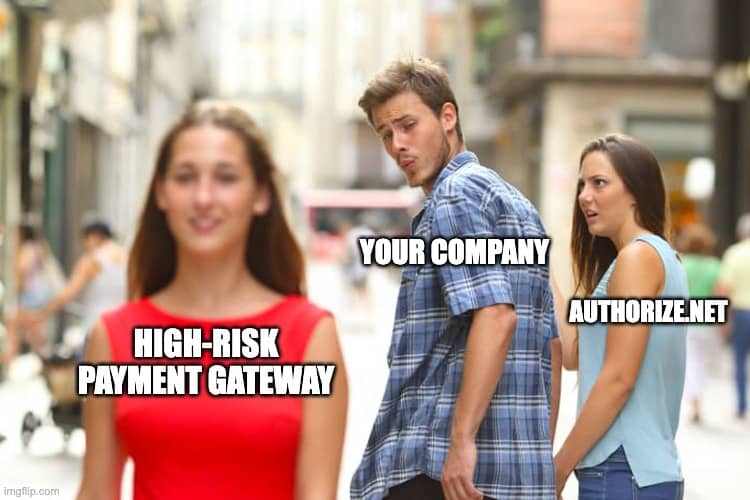What's the Difference? ACH vs. eCheck Payments

You know the complications of managing your finances if you run a business. Sometimes, it can seem like an overwhelming number of payment methods for your business to consider. Two forms of payment that can get particularly complicated: ACH vs. eCheck payments. There can be some confusion between the two forms of electronic fund transfers, but there’s a fundamental difference between them. Which one you use depends on what services you need and what better fits your business model.
Table of contents
- What’s an ACH Payment?
- What Are the Types of ACH Payments?
- What’s an eCheck Payment?
- ACH vs. eCheck Payments: How Are They the Same?
- ACH vs. eCheck Payments: How Are They Different?
- What’s Better for My High-Risk Business: ACH vs. eCheck?
What’s an ACH Payment?
ACH payment is short for Automated Clearing House payment. ACH payments allow businesses to withdraw money from one bank account to another. This type of payment completely excludes debit cards, credit cards or any manual transaction.
ACH payments are a form of Electronic Funds Transfer (EFT) managed via an app or a website. ACH payments move money from one bank account to another, so you can eliminate a credit card company from the financial transaction. An ACH payment will allow you to skip traditional paper checks or wiring money from one bank account to another.
You may be more familiar with ACH payments than you realize. If you get paid electronically, and that money is deposited directly in your checking account, it almost certainly comes via a direct deposit. This direct deposit runs through the ACH network. When enrolling in an ACH payment, you must give your routing number and bank account to your HR department when you work for a new business. Once they have this information, they can set up a regular direct deposit into your bank account or preferred financial institutions.
The National Automated Clearing House Association (Nacha) operates the ACH network. According to the organization’s website, Nacha moved $73 trillion in 2021. You still need a merchant account processor to access the ACH network, but all payments run through Nacha’s systems.
An ACH transaction has advantages for both the merchant and the consumer. Consumers can use an ACH payment to “set it and forget it.” This allows your business to use ACH payments for recurring payments, such as payroll, payment for recurring services and other options. The regular payments offered by ACH can be ideal for any business, and this flexibility helps explain the popularity of ACH payments.
While an ACH transaction can help make payments more manageable, you still need a payment processor to manage these services. Payment processing services can manage dozens or hundreds of charges at the same time. This batching ability ensures that a vendor can quickly move money from one bank account to another. You will have to pay a small fee to these payment processors, which helps explain why it is so important to find a payment processor that will keep rates as low as possible. Your business can often find discounted rates if you need a payment processor to handle multiple transactions, and this is something you should keep in mind when shopping for the best processor.
High-risk companies may face complications when attempting to take advantage of ACH payments. For example, the business may need to initiate a chargeback if there’s an issue with a payment. Chargebacks occur when a business needs to reverse a payment. They are expensive and can result in higher fees from the payment processor.
Your business will want to reduce chargebacks whenever possible. You should also identify a payment processor with decades of experience in this field and one capable of offering customized advice on keeping chargebacks to a minimum.
What Are the Types of ACH Payments?
Most people are familiar with the two main types of ACH payments: direct deposit and direct payment.
A direct deposit is a deposit made by an institution to an individual. For example, you have used an ACH payment if you get an electronic check as part of your paycheck. ACH payments are also how a government may deposit a tax refund in a taxpayer’s bank account.
Both of these processes operate via the ACH credit and ACH debit systems. ACH credits move money into an account. This process allows a customer to transfer money from their account into yours. The ACH debit system will move money out of someone’s account. This procedure can only occur when a customer gives their final sign-off on a payment. Individuals or businesses can conduct a sign-off electronically, allowing money to move quickly from one account to another.
What’s an eCheck Payment?
An eCheck payment is an electronic version of a check. There’s no paperwork and no credit card or debit card involved. All you need is a routing number and an account number. Because of this, an eCheck works similarly to an ACH payment, as it sends money from one bank account to another.
An eCheck uses the ACH payment network to process payments. eChecks are a form of ACH payment, and they evolved after Nacha and participating financial institutions developed the ACH payment network.
eChecks have many advantages when compared to the traditional method of payment. They’re swift, and money usually moves in 24 hours. They also have lower processing fees than credit cards, thus allowing you to save money. These low fees make them a preferred payment method for many businesses. They’re still not cheaper than paper checks, which have no processing fees. In exchange, you can move money electronically and automatically keep records. There’s no risk of lost paperwork, bad handwriting or someone leaving a check on a table and forgetting to deposit it. You also never have to worry about mailing an eCheck: All you have to do is click a few buttons, and the check arrives at its intended destination.
The similarity between eChecks and regular checks still exists on many levels. Like paper checks, an eCheck can bounce. Bounced eChecks can result in heavy fees incurred by the party that writes the eCheck. There are limits to how long a customer can request a refund and get an eCheck payment charged back. Like any other form of payment, this can mean fees for your business. It would help if you worked with a vendor with experience managing and reducing chargebacks.
Your business may need to accept an ACH or eCheck payment. You’ll need to work with a vendor that understands the similarities and differences between these types of payments. A vendor should also be able to provide you with adequate customer support resources and offer you reasonable fees.
Finding a vendor of caliber can be challenging for a high-risk business. Payment processors tend to charge higher fees for merchants with a greater risk of chargebacks. Zenti can help you find the appropriate payment solutions to fit your needs. Zenti also has specific experience with a vast array of high-risk business sectors, meaning that they know your business model and will be able to understand its specific challenges.
ACH vs. eCheck Payments: How Are They the Same?
ACH and eCheck payments have quite a few similarities. Consider the following:
- Both ACH and eCheck processing are forms of online payments that require no paper components.
- Both types of payments are more advanced and electronic versions of wire transfers. They don’t replace a wire transfer but can be more simple.
- ACH and eCheck payments require minimal maintenance from the payer. Once transfers are set up, they can go on forever. At the same time, both payments are easy to cancel. This flexibility gives individuals involved in electronic payments a few options for controlling payments.
- Businesses can use batches to process both eCheck and ACH payments. Batching payments means you can send dozens or hundreds of payments simultaneously. This process can save your business time and money. The money savings that a business can achieve via batched payments can be significant to your business. This depends on if you have a payment processor who can offer you price breaks based on how frequently you use their services.
- Both ACH and eCheck payments can clear within 1-2 business days. In some cases, the transaction process can be even faster.
ACH vs. eCheck Payments: How Are They Different?
There are still some significant differences from the similarities between the two. The critical difference is that ACH payments have a broader meaning. ACH payments involve many types, including debit, credit and more. eChecks are one such example of ACH payments.
ACH payments also give consumers more options. An individual or business can use ACH processing to make recurring payments. For example, let’s say you run a debt collection business. You work out an arrangement with a customer where that customer will pay you $500 monthly. You can create an ACH payment that will automatically remove $500 every month on a set day of the month.
In this example, you still have to be careful: The customer can change the terms of the agreement at any time. Stopping payment requires that the customer either cancel the payment. A situation may arise in which the customer’s bank account has insufficient funds to process the payment. If that happens, your business will have to reengage with the customer to ensure you’re getting paid what you’re owed.
In contrast, eCheck payments are once-and-done. Someone can use an eCheck payment to buy something, but you cannot use eChecks to send recurring payments. You can create a system that regularly allows customers to send an eCheck, but ACH payments are more likely appropriate for recurring expenses.
What’s Better for My High-Risk Business: ACH vs. eCheck?
There’s no set answer. Each of these payment methods may be appropriate in the right circumstances. Electronic fund transfers like ACH payments and eChecks have been around for decades. Both enjoy widespread use. Anyone with the right technology can take advantage of either payment method.
ACH payments and eChecks have advantages over cash, paper checks and credit cards. They have lower processing fees and can move money quickly. Both payment methods can remove paper record-keeping from financial transactions, allowing your business to simplify its record-keeping process.
ACH payments and eChecks aren’t without their drawbacks. If you accept ACH payments or eChecks, you need to find a payment processor who can work with you to meet your business requirements.
One of the challenges for any high-risk business is finding a payment method that reduces risk and has low fees when a chargeback does occur. A company can use ACH payments and eChecks to minimize the risk of chargebacks. Both come with robust security protections that ensure that charges are only made when authorized users make them. ACH payments that occur regularly can also send reminders every month. These emails let the user know that a business is about to withdraw funds from its account. This reminder allows someone to investigate the upcoming charge further and make a cancellation if necessary.
Businesses that incur chargebacks on ACH or eChecks are in luck: Nacha rules require that chargeback percentages are less than 1% of the total cost of the transaction. This relatively low number can keep costs down. The low charge helps explain why many businesses attempt to steer customers to ACH payments.
When it comes to payment processors and merchant services, you have no shortage of options. As a high-risk business, you may find that your business can benefit from accepting ACH payments and eCheck payments. If you need more information on taking either of these payments, contact Zenti today. At Zenti, we can make our decades of experience available to you. We offer numerous payment processing tools, including ACH or eCheck payments. We strive to give you an array of payment options to conduct your business profitably.
At Zenti, we’re here to help. Contact us today for more information.
Read Next

Find out whether Authorize.Net works for high risk merchants, what restrictions you might face and how to get approved.

Get expert advice on selling CBD products on Shopify, including compliance tips and setting up secure payment options.

Find out why Square may deactivate merchant accounts and steps to resolve issues and maintain uninterrupted payment services.
Need a High-Risk Merchant Account?
Disruption-free payment processing at the best price for your situation, guaranteed.
Get Free Guidance Now!